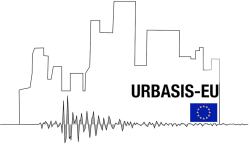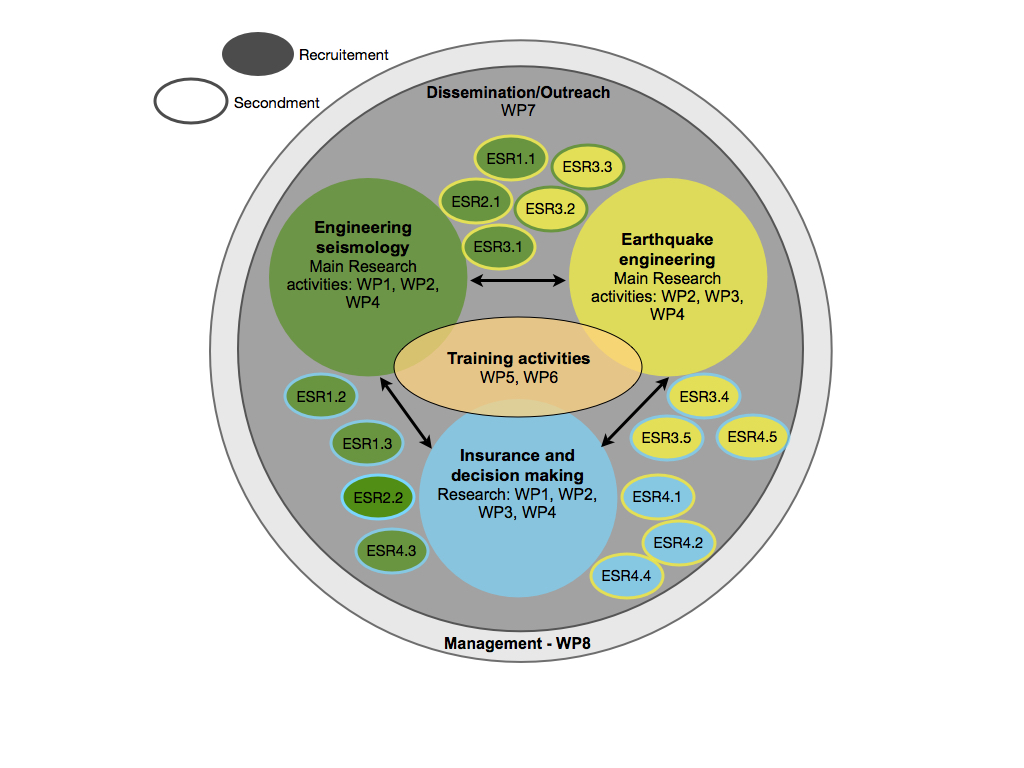From 2018 to 2023
Over the last two decades, inter-disciplinary projects were carried out in Europe focused on the fields of earthquake engineering, engineering seismology and seismology (e.g., SHARE, SYNER-G, NERIES, SERIES, LESSLOSS, PERPETUATE, REAKT, NERA, STREST, SIBYL, EPOS, SERA for engineering seismology and GEISER and SHEER for induced seismicity...). These involve the development of research infrastructures (e.g., high performance computing, observatory systems) and services (e.g., SHARE seismic hazard web-services, ORFEUS strong motion databases, etc...). However, these projects have not included large training components for the next generation of experts in the field. Moreover, in general, seismic hazard is defined indiscriminately across an area (national or continental) without distinguishing the most exposed areas. The efforts developed are uniform and non-proportional to the level of risk.
We want to reverse this practice : since the urban and sub-urban or industrial environments result in the concentration of exposed elements, in terms of populations and resources, the hazard must be assessed at the metropolitan level. At this scale, some factors that are specific to urban and industrial areas in Europe will thus be analysed in detail, including : the impact of a low-probability earthquake on a city, including the infrastructure ; prediction of ground motion produced by natural or induced seismicity at short distances ; modelling of large-distance earthquakes and their impact on the modern built environment ; spatial variability of ground motion that affects non-earthquake-designed low-rise buildings (e.g., masonry in historic downtown areas) ; lateral variability of site effects at small scales and in complex media ; ground motion particularities in cases of very deep and large basins with strong impedance effects ; liquefaction-induced phenomena (e.g., settlement and lateral spreading of levees in The Netherlands related to induced seismicity, or liquefaction-induced phenomena of several sites in southern Europe) ; interactions between ground motion, secondary effects and engineering structures or lifelines ; and loss modelling for large European urban scales based on vulnerability and risk assessment. URBASIS will promote interactions between engineering seismology, earthquake engineering, and insurance and decision-making activities.
The estimation of the hazard in low seismicity areas where extreme events are rare is difficult to justify to a non-expert because these events lie within the first order compared with the black swan theory proposed by Taleb, which illustrates a cognitive bias that leads us to the erroneous conclusion that rare phenomena will not happen. These events might have grave consequences because critical facilities and industrial areas, as well as large populated urban centres are not sufficiently prepared. As the recurrence interval of major earthquakes is so much longer than the periods of recent rapid urbanisation, Jackson stated that the major catastrophes lie ahead. Moreover, in moderate to high seismicity regions (e.g., the Mediterranean region), the vulnerability of the existing urban centres is high while the resilience to major catastrophic events is typically relatively poor.
After the strong expertise developed during the SHARE and STREST (EU) programmes, in WP1 the two lead participants (ULIV, GFZ) will develop new concepts to define prediction models for events with low probabilities of occurrence but high consequences (LPHC). This is a key element of the project, to finally focus on events that can arise at long distances and that impact upon modern cities and their infrastructure, lifelines and industrial environments, and might result in dramatic consequences. Traditional models are not necessarily well suited, and significant reflection will be necessary to define what LPHC events are and how to evaluate them. Hazard and risk assessment based on 3D-physics-based ground-motion modelling will be applied (POLIMI), to compensate for the poorly constrained ground-motion predictions for such events, especially close to the earthquake sources, thus posing serious threats to urban environments.
The active participation of the AON’s impact forecasting group, MUNICH-RE’s Geo-Risk team and AXA’s Catastrophe and Reinsurance Risk Group, together with the supervision of ESRs, will provide strong benefits for the success of WP1. AON is the world-leading reinsurance intermediary and full-service capital advisor. They empower their clients to better understand, manage and transfer risk, through innovative solutions and personalised access to all forms of global reinsurance capital across treaties and facultative and capital markets. MUNICH-RE is one of the world’s leading reinsurers, continuously working to provide (re) insurers with a more accurate risk assessment for catastrophe (re) insurance purchasing. AXA is a worldwide insurance company leader, developing research on earthquake risk models to provide the better insurance policy to their customers.
Moreover, during induced seismicity that can be triggered by production of gas and oil, or during geothermal production, events can have non-negligible effects when they occur close to cities or in areas protected with a large-scale network of levees and other geotechnical structures. Important questions exist related to the sequences of such events, on how to estimate the maximum magnitudes, and how to evaluate seismic ground motion over short distances, and the induction phenomena for these specific events. Recent examples in Switzerland, The Netherlands and USA have shown the impact that even modest seismicity can have. WP2 will be focused on this issue, to develop predictive models that incorporate the temporal and spatial distributions of the seismicity (UGA), and infer the seismic ground motion in urban and industrial areas (ULIV). This WP will be at the interface of the three main fields of research.
In urban areas, site effects can often generate greater damage due to ground-motion amplification and soil non-linearity and liquefaction. Site effects are associated with difficulties in seismic hazard assessment and risk analysis, and the scaling between the laboratory and in-situ conditions is questionable. Moreover, new knowledge recently acquired in ergodic seismic hazard and non-ergodic site-specific hazard assessments should be clarified to improve their transfer to the private sector. It is the objective of WP3 (lead ETHZ) to improve the integration of site effects into hazard and risk analysis, and also to look into the interactions between ground motion and responses of buildings (OGS, AUTH) and infrastructure (AUTH), involving participation of RESONANCE, GEOTER and IFSTTAR. Indeed, most hazard analyses focus on ground-motion predictions regardless of the urban environment that might contribute to the ground motion. We aim to experimentally demonstrate that a city can behave in many ways as a meta-material for seismic wave (UGA, OGS, POLIMI) : i.e., each building inside a city can react as a resonator that traps a small part of the seismic surface waves. The collective behaviour of the buildings might produce forbidden frequency bands or ‘band gaps’ that can be exploited to protect sensitive structures from the potentially destructive surface waves caused by earthquakes. The design of a city can provide an anthropic ‘cloak of invisibility’ that would be a societal revolution in the field of seismic hazard protection in urban environments. Finally, a comprehensive 3D multi-scale physics-based scenario of earthquake effects in large urban areas will be modelled (POLIMI, MUNICH-RE), with analysis of the multi-coupling effects between source, site and city effects, including the spatial variability of seismic ground motion. Usually, seismic risk is expressed as the convolution of seismic hazard and seismic vulnerability, considering their time invariance and the lack of data required for the characterisation of hazard and vulnerability at scales suitable for integrating the space variability of the global urban environment.
However, risk probability might change over time : e.g., as a consequence of induced seismicity sequences or aftershock sequences, coupled with degradation of buildings. Furthermore, the lack of information on building responses might influence the accuracy of any risk assessment. In the case of an active policy for risk mitigation, the impact of decisions based on time variability and incompleteness of information might have critical effects for decision making, to influence the investment devoted to seismic risk mitigation and based on cost/ benefit analyses. The aim of WP4 is to propose a model to account for the time-variation of the risk probability (GEOTER, AON). Probabilistic seismic hazard, or the occurrence probability, of damaging aftershocks (or induced events) will be coupled with : the time-variation of the building/ lifeline responses ; the relation between ground motion and vulnerability and damage assessment of buildings and infrastructure (UGA, OGS, AUTH, AXA, RESONANCE) ; the impact of missing information on the evaluation of hazard (ULIV) ; and the assessment of vulnerability at city scales, including their infrastructure and utility systems (GFZ, POLIMI, OGS, AUTH, MUNICH-RE). The participation of GEOTER, RESONANCE, MUNICH-RE, AXA and AON in WP4 will be a key element from a strategic point of view, both being face to face with the decision makers during their activities.
Due to the involvement of the URBASIS participants in the previous European projects, URBASIS will take an important step towards reducing and taking into account the risk in urban areas, starting from the up-to-date state of knowledge. Unlike previous projects, URBASIS will propose a breaking of concept by considering the urban environment as the heart of the process, considering an integrated approach to seismic phenomena that impacting upon cities, and to provide the ESRs with unique multi-skill training. The accomplishments of the individual projects of each of the recruited ESRs will be fostered by exposing ESRs to trans-disciplinary dimension, i.e. engineering seismology, earthquake engineering, and insurance and decision-making domains. The excellence of the academic participants, their recent involvement in major European projects and the Doctoral and Masters programmes in their universities, will be the ingredients that are necessary to complete each ESR’s individual project with success.
Updated on 30 avril 2021







